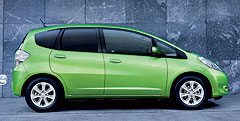Paris show: Honda Jazz hybrid eco details
BY TERRY MARTIN | 28th Sep 2010

These figures place it behind benchmark cars such as the diesel-powered Ford Fiesta Econetic, which is the Australian fuel economy leader with 3.7L/100km (and 98g/km), while the Toyota Prius hybrid emits the lowest amount of CO2 with 89g/km (and consumes 3.9L/100km).

Pre-release information from Japan also indicated the Jazz hybrid would emit just 77g/km of CO2.
Under consideration for release in Australia, the car that Honda bills as the world’s first light-sized petrol-electric production vehicle will be powered by the same IMA petrol-electric drive system as seen in the Insight hybrid.
This means it uses a 65kW/121Nm 1.3-litre SOHC eight-valve i-VTEC petrol engine combined with a continuously variable transmission, with a 10kW/78Nm synchronous AC motor sandwiched between the two to create a parallel hybrid system with total outputs of 75kW and 199Nm.
Honda also highlighted that the integration of the hybrid system into the Jazz has not diminished interior space, the vehicle retains its folding rear seats and the boot floor remains at the same level as conventional-engined models.
The IMA battery pack and power control unit have been integrated in the area under the boot floor, keeping the normal above-floor cargo volume of 300 litres. With the rear seats folded, this extends to 831 litres.